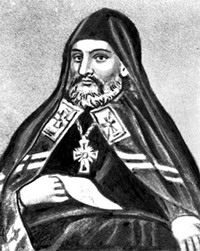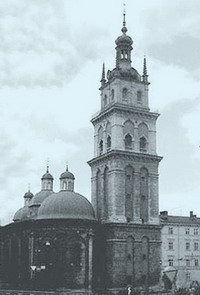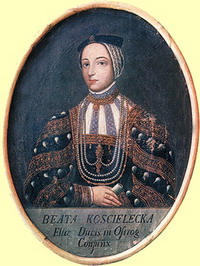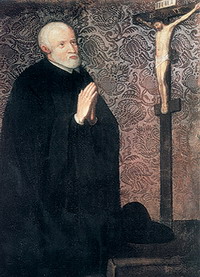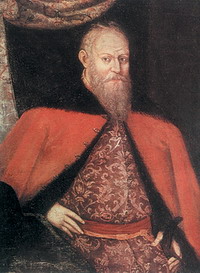development of literature, music, architecture, fine arts, UKRAINE IN THE SECOND HALF OF XVI - first half of XVII century.
Principal PROCEEDINGS
- polemic - a mirror of spiritual life and the pursuit of ideological Ukrainian educators end XVI - first half of XVII century.
CHRONOLOGY OF EVENTS
|
1577 |
Free was published in the book "On the Unity Church of God," Peter complaints. |
|
1572-1629 he |
Construction ensemble Assumption Church in Lviv. |
|
1580 |
Completion of the Palace of Constantine Kornyakta in Lviv. |
|
1587 |
published a book in jail Gerasim Smotrytsky. It includes two treatises: "Keys to the Kingdom of Heaven" and "new Roman Calendar". |
|
1588-1616 he |
and writer, cultural and civic leader John Vyshensky. |
|
1595 |
construction in Lviv Benedict Cathedral (architect Peter the Roman). |
|
1609-1615 he |
construction in Lviv Boim Chapel. |
|
1619 |
Building Chapel Kamp'yaniv in Lviv (architects and Paul Roman Vojtech Kapinos). |
PERSON
About Ivan
Vyshensky left very little information. It is known that he was born in the town ship Cherry in Lviv, and to indicate that it acquired last name. Name John - also gain years later: so called in monastic Vyshensky. At least around secrets and education writer. Holding the pen, he made efforts to criticize the then European school and university education, having related them with other civilization before the conquest "of Latin charm." Meanwhile, researchers are certain that he was Vyshenskyi Latin training, learning, perhaps in the Jesuit College. Scientists do not deny the relationship of the Reformation Vyshensky trends. However, the duration and nature of those relationships is not known. Probably they were determined the search for truth, which did not give peace passionate soul Vyshensky. However, linking themselves with Orthodoxy, he was not avoided controversy. And not only the idea of the union did not give him no peace: tormented relationship with Lviv brethrens, which was first in peace, then - as argued, does not beget a long time in jail under the tutelage of Prince Constantine. After all, he is increasingly inclined to the secluded life. In the 80 years moved to Mount Athos (the peninsula in the Aegean Sea, where long authoritative Orthodox monastery located). Since Mount Athos sent home special messages - messages written messages like the Apostle Paul. During 1604-1606 he lived in Ukraine, but returned again to Mount Athos, where he died.
Folklore, the development of literature
In
XVI - XVII century. fell flourishing Ukrainian epic, doom, ballads, historical songs, which the Ukrainian people responded to the new conditions of its historical development.
creators and executors dumas and historical songs were minstrels, bandurists, lyre.
under the influence of humanism and the Reformation Ukrainian literature XVI - XVII century. increasingly used the means of folklore art. Meanwhile literary tradition penetrated into the oral folk tradition. Such interference livelier development of Ukrainian literature, enriched it with new genres and forms, promoted development of literary generations, particularly drama and lyricism.
Another important feature of the Ukrainian literature was the emergence of Polish-and Latin-works , in which most embodied the idea of Western European art. Yes, Latin and Polish-Ukrainian poetry was largely secular in content and based on the laws of the European Renaissance art. Among the writers of that era famous Sevastyan Klenovych (c. 1550-1602) - Ukrainian Latin poet and Stanislaw Orzechowski-Roksolana (1513-1566) - a speaker, writer and publicist.
polemic
numerous journalistic pieces that related to religious life, including problems of the Union of Orthodox and Catholic churches. Polemical treatises written by both supporters and opponents of the union - that representatives of different camps, participating in public debate. Ukrainian Orthodox polemic writers passionately defended the right of native churches, stands opposed Catholicism and adapted. most out polemicist were John Vyshenskyi, Gerasimos Smotrytsky, Meletii Smotrytsky Stephen Zyzaniy, Ipatii Potiy, Job Boretsky.
Chronicles
significant place in the Ukrainian chronicle those times belonged Gustynskogo Chronicle , created in the first quarter of the XVII century.
dramatic literature and theater
In
XVI - first half XVII. Ukrainian drama began to take shape.
However, significant works of drama did not exist, although the first mention of the performances from the end of the XVI century. At the beginning of the XVII century. tended to be so-called school drama.
In the first half XVII. Ukrainian developed a traveling puppet show - crib.
architecture and urban planning
- Old City, vidbudovuyuchys would acquire other architectural features. unrecognizably changed, including Lviv, lived in jail.
- have been many new cities. Among them - Zhovkva Brody, Stanislav (now Ivano-Frankivsk), Bershad, Ternopil, that laid a fortress-residence of the barons.
- favorable for the emergence of new cities in western lands were, more removed from the nomadic steppe.
- in Kyiv region, Bratslav, Volyn, which at that time suffered from the Tatars and Noghay attacks, the city largely disappeared from the settlement of ancient settlements, when for the construction of city walls and fortifications used the remains of defensive structures of the past.
- Urban XVI - first half of XVII century. were heavily influenced by European Renaissance. Especially vivid Renaissance features implemented in Western cities. After bridge construction projects ordered by architects sometimes Europeans. Some architects, foreigners by birth, found a second home in Ukraine and realizing their creative ideas here, combining the knowledge gained in Europe with local traditions.
- leading role in the architecture is Renaissance secular buildings - town hall, castle-palaces, housing townspeople . A unique example of Renaissance building a group of Lviv buildings: buildings in the Market Square - house Kornyakta, Black stone , attractions associated with the Lviv Dormition Brotherhood - Assumption Church, the Three Saints Chapel, Tower Kornyakta. The authors of these projects was Paul of Rome, Vojtech Kapinos, Ambrodzho committed, Peter Barbon et al.
Defence facilities
- Urban consolidation is often built of wood. The wooden fortress was an essential feature of the lands of the Dnipro region `s and the Left Bank, where there was no other building materials. Wooden fortifications had, in particular, who was Kyiv.
- architecture used in the defense and new building methods. Their establishment was associated with the emergence of new types of firearms. In another erected protective walls: they are lower but much wider.
- In the XVI century. due to construction work got new features famous the Thames.
It was rebuilt and - lock in jail.
During - XVI - early XVII. reorganized and Kamenets fortress. Its besieged stone, erected new towers.
- Glory insuperable fortresses in the XVII century. heads are filling bastions in Brody and Berezhany. Brodie Castle , built in 1630-1635 he was a strong fortification that little look pentagonal castle with five bastions, which combined with the western side of the town's fortifications with ten bastions.
Construction - Castle Berezhany was significantly prolonged. It had begun in 1535 and carried out with the old (tower) system. Subsequently, the castle owners have decided to give it a more modern look. That is why the towers bastions, built in the middle of XVII century., Combined it with high thick walls, typical of earlier times. The two tiered 'galleries, navershya lace, fine carving castle to bring Renaissance palaces.
- Castles in Zbarazh Zolocheve Pidgir'ya and combine features of military architecture of the palace.
- defense needs also be taken into account during places of worship. Large monasteries sometimes acquire the look of real fortress, protected by strong walls and towers, bastions.
- These are in particular Trinity Monastery in rivers in jail, Pochaivskiy Assumption monastery.
 English
English







